
Two German Cities, Cologne (Köln) and Freiberg
Summer 2004
Summer 2004 travel brought on so many wonderful experiences, it is difficult to single out any one highlight. The most recent, still vivid, experience was a trip to Germany at the end of September.
The simplest, cheapest way to go to Germany from our home in England is to fly from Luton (near Flitwick) to Dortmund, an industrial city in central Germany (amazingly, about $30 round trip). At the Dortmund airport we boarded a train in the nearby village of Holzwickede and were in Cologne (Köln) in an hour.
The Internet is an amazing tool for travelers. I made plane, train, and hotel reservations on the Internet, including an on line train ticket through Germany. I believe it is best to avoid travel agencies on the Internet and go directly to the suppliers. The travel agency pages are useful for initial planning, but when I can find the web page of the actual hotel (not always a trivial process) I consistently saved money and got better options. The German internet train reservations system is highly refined, with all train schedules and a truly simple user-friendly interface, including internet discounts. I printed my own ticket, then on the train just showed it and the charge card used to book it. I made one (minor?) mistake in the process. In returning back to Dortmund from Cologne, we grabbed the first available train, which, inadvertently, was not a valid train for my ticket. It seems that regional trains and the fast ICE trains are operated by separate companies, so the choice must be made when purchasing a ticket. Here was one instance where my lack of skills with the German language actually paid off. The kind conductor, after explaining that the ticket was not valid on the train, rather than attempting to explain more, simply threw up his hands and said "Don’t worry." He then, upon running into the same problem with a German student sitting beside me, kicked him off the train at the next stop.
Cologne has always been one of my favorite cities, having visited on many occasions. Being a convenient stop on the way to Freiberg, the conference site, and since Pauline had not seen it, we spent two days there. I had opted for a hotel near the Cologne station, since I knew that the cathedral was also next to the station. Only after arriving in Cologne did I realize that Hotel Ibis is actually IN the Cologne station. After checking in we proceeded to our room with a plan to deposit bags and head for the Kölner Dom (Cologne Cathedral). As we entered our room on the fourth floor to our great excitement we saw the Kölner Dom towering just outside our window.
The Kölner Dom is the most awe-inspiring structure I have ever seen. This huge, mountainous feat of architecture, designed to emphasize vertical lines, leads one up and up and up to heaven, past innumerable sculptures, and endless elaborate carving, straining ones comprehension beyond all limits.
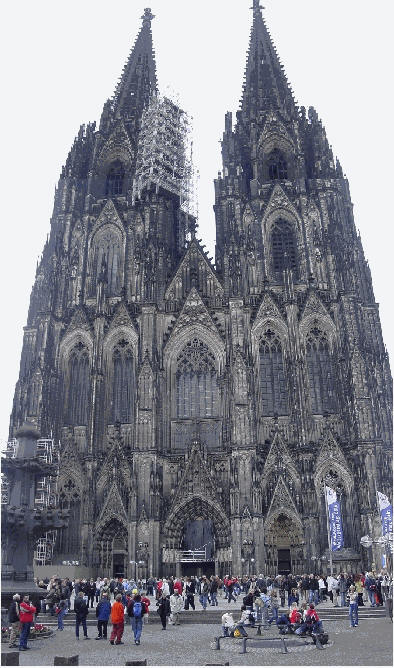
The Kölner Dome
Hard to get in a single photo, I pasted two together here.
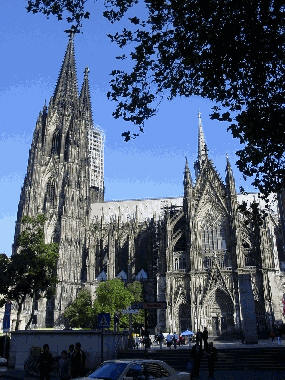
The Kölner Dome-from the side-This is about 2/3 of it.
I first came to Cologne over thirty years ago, walked out of the station totally oblivious to what was awaiting me and looked up to see the most astonishing sight I had ever seen. I stood in front of the cathedral and stared in amazement for at least an hour and kept coming back again and again to stare at it. It still has the same effect on me. Everyone who visits the Kölner Dom comments on the difficulty of photographing it. It is so large that one cannot get it all in a field of view. I always remember bringing my mother to this place during our trip through Germany. I had wondered how she would react to it. I watched her standing in awe with tears streaming down her face, repeating over and over, " It is so awesome; I just cannot believe I am actually here."
Under construction for over 600 years, it is, in fact still under construction. Although construction on the present structure started in the eleventh century, a religious structure has existed on this site back at least to the third century. With a tower extending upwards to 130 meters, climbable to 100 meters on 500 steps, it is one of the largest cathedrals in the world. Although neither the largest nor tallest, it is said to sport the largest facade of any cathedral.
Inside is equally awesome with towering vaults, sculptures, stained glass, and among other unique items, they purport to have remains of the three Magi.
Allied bombing in World War II flattened the entire city except for the Kölner Dom, which still stood, almost unscathed after taking a dozen direct hits.
Sitting on the edge of the River Rhine, the Kölner Dom is surrounded by miles of wonderful pedestrian streets that begin at the cathedral and continue along the Rhine as well as through the city. The streets are lined with entertainers, unique restaurants, great museums, galleries, and a dozen beautiful and unique churches. Wandering around the streets near the Dom we selected a tiny, hole-in-the-wall, typical, Köln restaurant for dinner. As soon as I saw Schweinknöchel (pig knuckles) and sauerkraut on the menu, I went no further; Germans really know how to cook pork. This is one of those language things that could be misleading. Before my friend, Wolfgang, taught me about Schweinknöchel I imagined it as a pile of bones, a delicacy for someone who was not hungry. This dish is quite the opposite; it is about two pounds of delicious pork surrounding what must be a pig’s knuckle. Few people could eat all of it. Pauline went for the Wienerschnittzel. It is always a tough decision at meals whether to drink the German white wine, the best in the world, or their beer, also unbeatable.
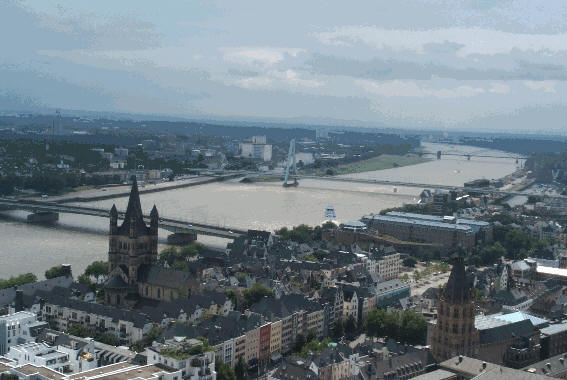
Cologne from the Kölner Dom tower-Overlooking the
Rhine River. St. Martins Church is at nine o’clock.
Photo courtesy of my intrepid son, Jim, who made it up
the 500 steps during his visit.
The area along the Rhine, another restaurant haven, also features dinner show boats, tour boats, and great bridges across the river. The area here especially comes alive at night with all the beer gardens that line the river. By the time we had arrived back at the hotel there was a light rain, so we decided to call it a day. I find it a great pleasure to lie in bed, look out the window, see the towering steeples of the cathedral, and listen to the bells tolling. It made it really difficult to get up in the morning.
We made stops in several other beautiful churches ranging from the medieval to modern. In one of these, The Antonite Church, is the famous "Floating Angel", a special find for Pauline. This sculpture was melted down to make bullets during the war, but fortunately, the original mold survived and was used to replace the sculpture. We inadvertently stumbled onto a 17-kilometer marathon through the city streets and watched as thousands of runners jogged by to the cheers of spectators lining the cordoned-off streets.
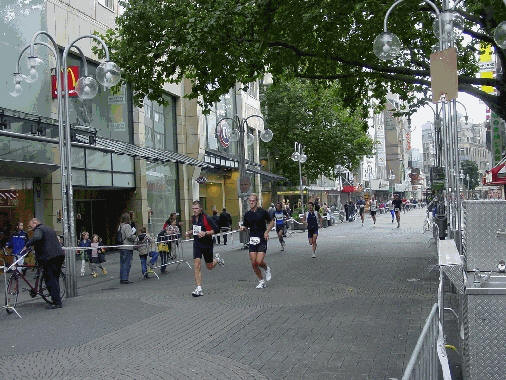
17 Km Run in Cologne (Köln). Normally, this is a
pedestrian street.
There is so much to see and do in Cologne that I once again broke my vow to climb the 500-step tower at the Kölner Dom and elected instead to paint a beautiful scene along the Rhine. I rarely use pictures in WWT journals that I didn’t take, but I made an exception in the case of a picture made previously from the tower and graciously donated by my son who could never turn down a cathedral climb.
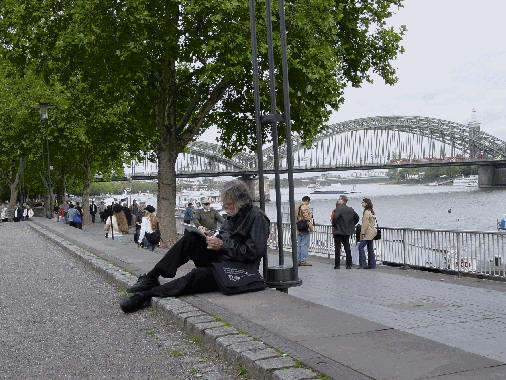
Painting along the Rhine River-Railroad bridge in
background goes into the main station HBf.
Next picture shows the subject of the
painting.
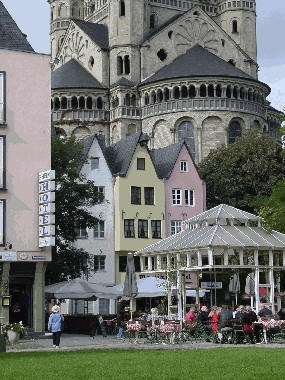
St. Martins Church-I painted this scene.
You can
see Pauline at 7 o’clock heading for an antique store to look at egg cups.
I had a very strange existential experience in Cologne. In my early visits to Cologne for some reason I burned in a permanent mental image of the Kölner Dom on the Eastern bank of the Rhine, as well as a mental map of the relative layout of the city. To my great surprise, I finally discovered during this trip that it is actually on the Western bank, so my mental map of the city is actually upside down from reality. After many mental exercises I am still unable to correct this mental image and my sensation of North and South remains completely reversed in the city.
Whereas the Köhner Dom is awesome, the Freiburg Münster, constructed with the local pink sandstone during the eleventh and twelfth centuries, is truly beautiful. It has the reputation for possessing the most beautiful tower in Christendom, a claim I would believe. Like so many European cathedrals it is surrounded by scaffolding and requiring continuous maintenance. The entire front portal was completely covered, and, unfortunately would remain covered for our entire stay. We spent hours viewing it inside and out over several days. It has some of the most spectacular gargoyles I have seen; they also serve as water spouts to drain water from the roof. The sculptor had a great sense of humor, with one of them being a lady folded at the waist, holding onto the roof with hands and feet and water squirting from, guess where. That such a sculpture made it past the censors onto a cathedral is amazing. The Freiberg Munster is worth waiting for rain just to see the gargoyles in action. The church is surrounded by the cobble stoned market square, where a market is held every day.
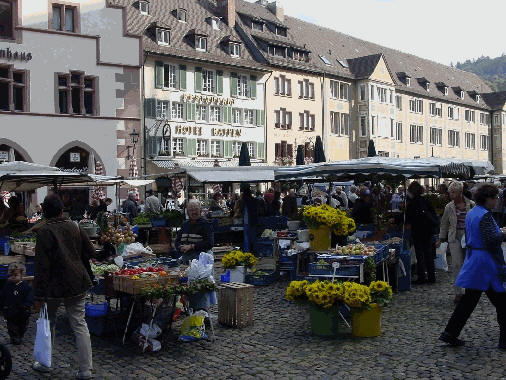
Freiberg Market Place-Held every day, you can buy
almost anything here.
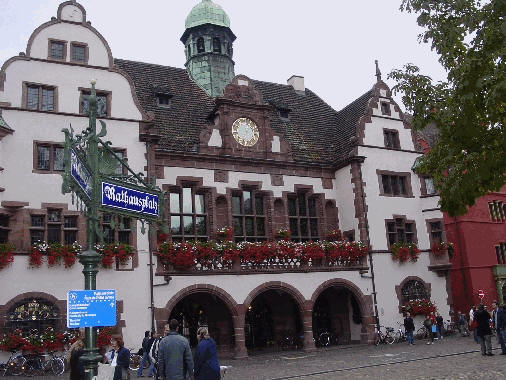
Freiberg Rathaus-I painted this scene. As I sat
here, a big truck rolled up between me and the scene and assembled stalls for a
coming market. The same thing happened in Erlangen.
I did manage to conquer the 300 narrow, spiraling steps up the Freiberg Münster tower. From the top I was rewarded with an awesome view of the cathedral, the medieval, cobble stoned, market square below, the city, and the Black Forest. As an added bonus, I entered the bell tower, where 16 huge bells, nearly 30 tons of metal, ring regularly. Being in that tower with all those bells going is enough to enthuse anyone. I could feel every bone in my body vibrating. The 3400-kilogram (3.7 ton), e-sharp, Hosanna Bell, the oldest operating church bell in Europe (circa 1250 AD) still performs daily.
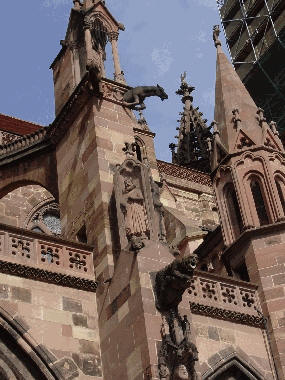
Freiberg Münster Gargoyles-It is worth waiting around for rain just to see them in action
I made a new discovery about the famous golden angel sculpture, which plays her horn to the streets below and can be seen on many postcards. The life sized statue is so high up on the tower she is barely visible from the ground; however, from the tower, one can lean over the wall and almost touch her. In leaning over the wall to take photos from various vantage points, I discovered that there is not one but at least three, almost identical, angels on different corners of the tower. No one I had talked to realized that there were more than one.
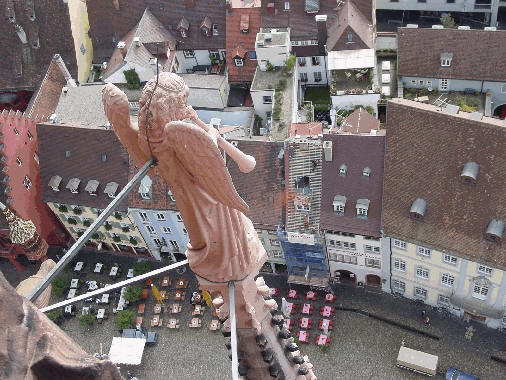
One Of The Three Golden Angels Looking down on the Golden Angel Restaurant (red tables). Notice her lightning rod. You can see that a person on the ground below is almost indiscernible, so the angel looks that small from the ground.